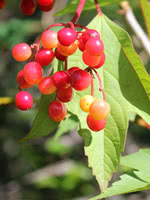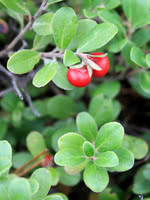Mon-Fri 9am - 5pm Mountain time
Highbush Cranberry vs Bearberry
Viburnum opulus var. americanum (trilobum)
Arctostaphylos uva-ursi
COMING SOON
NOT AVAILABLE THIS SEASON - MIGHT RETURN
Highbush Cranberry produces attractive white flowers in late June and bears edible fruit that matures to a bright red colour in the late summer.
This shrub, native to much of Canada, is fast growing, and its fruit can be eaten raw or cooked into a sauce.
Bearberry is a dwarf shrub known for its creamy pink flowers and red edible fruits.
It is great as a filler in gardens and flowerbeds in place of invasive ground cover plants, like English Ivy.
Bearberry will attract hummingbirds, butterflies and bees to your property. It is one of the top 12 plants recommended by the Alberta Native Bee Council to support pollinators.
Highbush Cranberry Quick Facts
Bearberry Quick Facts
In row spacing: 0.6 m (2.0 ft)

